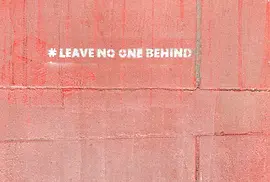ROUTED #20
Desplazamiento, gobernanza y derechos humanos

'The black door within a red heart.’ Original work by Eliseo Ortiz, based on visual interpretation of Mohsin Hamid’s science fiction novel, Exit West
In July 2022, the cooperation project FFVT (Forced Migration and Refugee Studies: Networking and Knowledge Transfer) held its first summer school in the famous Castle of Nuremberg, dedicated to ‘Displacement, governance and human rights’ (which, hopefully will be followed by many more).
Following the discussions during this international and interdisciplinary week, we had the pleasure of inviting participants, lecturers and organisers to reflect and write about their research on migration and refugee protection regimes across the world. This is how authors found co-authors and new interdisciplinary approaches, how they intensified their exchange and renewed their perspectives.
Routed Magazine and FFVT are therefore thrilled to present this special issue, a collection of articles that explore the history, laws and policies of refuge, as well as the dimensions of gender, identity and representation in displacement.
In these articles, we examine mobility regimes through various lenses. Beyond the legal and technical aspects, migration policy can be understood as an instrument of population control, by establishing who is allowed to enter and who is encouraged to leave. Refugee protection and displacement hold diverse meanings and implications across different contexts: from the histories of cross-border kinship and affinity in southern Africa to the globalised state dynamics of bordering imposed on postcolonial spaces. Moreover, the implication of different national, international and non-state actors complicates the refugee protection landscape in countries such as Jordan and Lebanon.
This issue also looks at three ongoing displacement crises: the situation of those internally displaced in Afghanistan one year after the Taliban takeover, the gendered aspects of internal displacement and refuge in Ukraine, and the temporary protection status created for Venezuelans in Colombia. We also look back in history through the story of a single mother negotiating her family’s mobility in post-World War II Europe.
Furthermore, we also examine how mobility regimes rely on specific languages that reproduce institutional ideas of what is legal or possible, often echoed in the news, where migrants are generally underrepresented and portrayed within a security frame. These representations meet the opposition of migrant vocabularies and local understandings of movement – with terms such as harga challenging the concept of ‘illegal migration’ – as well as other forms of resistance, including countermapping, memorialisation, and communicating with the families of border victims. At the same time, children of migrants often grow up among different representations of community, cultures and values, in a process that can be very enriching for diaspora youths.
We would like to thank the writers for sharing their research and experience through these pieces. We also want to extend our thanks to Dr Lorenz Wiese and Prof Dr Petra Bendel from FFVT for organising this collaboration, the editorial and communications teams at Routed Magazine for coordinating this issue, and particularly Shaddin Almasri for orchestrating this encounter. To all our readers – thank you for joining us for this special issue! We wish you a happy reading.






%20Leave%20no%20one%20behind%20-%20Gvantsa%20Gatenadze%20.webp)
%20article%20photo.jpg)
%20Kutupalong%20Refugee%20Camp%2C%20Cox's%20Bazar%20-%20Teknaf%20Highway%2C%20B.jpg)




